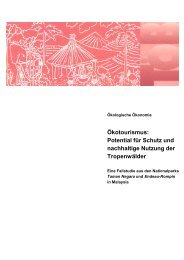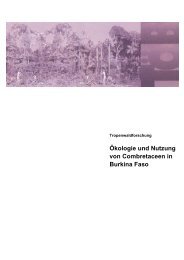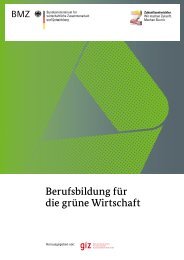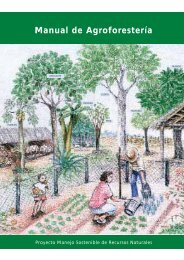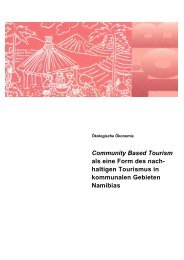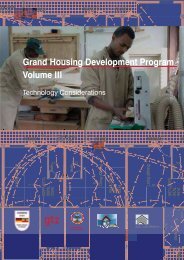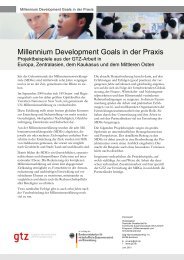Status Report on Global Neem Usage - Gtz
Status Report on Global Neem Usage - Gtz
Status Report on Global Neem Usage - Gtz
- No tags were found...
Create successful ePaper yourself
Turn your PDF publications into a flip-book with our unique Google optimized e-Paper software.
3. NEEM AS A NON-SYNTHETIC PESTICIDEc<strong>on</strong>diti<strong>on</strong>s for at least 1 year. Practical sizes for bags of crushed seeds are 250 g and 2 kg.Their principal use is for water extracts in households and gardens.The press cake is packed and handled in the same way as the crushed seeds. It is useddirectly to c<strong>on</strong>trol soil-borne pests and as a fertiliser. Normally 30 g per square metre isadded to the soil a few weeks before sowing.The most comm<strong>on</strong> way of using neem oil as a pesticide is <strong>on</strong> the basis of an oil-and-wateremulsi<strong>on</strong>, which needs an appropriate emulsifier. Around the world many different emulsifiersare used. The principal ingredients are various vegetable oils and detergents. It is importantthat additives are properly biodegradable so that the ecological benefits of neem are notcounteracted. <strong>Neem</strong> oil and the emulsifier have to be mixed in the right proporti<strong>on</strong>s to get theideal emulsi<strong>on</strong> in water (the neem oil should not float <strong>on</strong> the water). Normally the mixture ofoil and emulsifier is used diluted to between 0.5 and 1.0 % in water. The diluti<strong>on</strong> chosendepends <strong>on</strong> the type of plant: 0.5% is used <strong>on</strong> plants with soft leaves (e.g. many vegetables);1 % can be used <strong>on</strong> plants with hard leaves (e.g. many fruit trees and ornamentals). A thirdcomp<strong>on</strong>ent can be added: sodium salt, normally known and used as “baking powder”, but atthe same time it is very effective against many phytopathogenic fungi, especially mildew.According to many users, the home-made pesticides are more effective than the formulatedneem-based pesticides. The reas<strong>on</strong> is that in additi<strong>on</strong> to the insecticidal effect, the rawmaterial has str<strong>on</strong>g repellent and feeding-inhibitory effects. On the other hand the raw materialis a plant nutrient and fortifies the plants treated. Formulated neem-based pesticides d<strong>on</strong>ot have these advantages. Most of the users of home-made pesticides are hobby gardeners.After a period of time they tend to stop using any other garden additives like fertiliseror pesticides.- Formulated neem-based pesticidesFormulated pesticides can <strong>on</strong>ly be made from neem using more advanced technology andknow-how. And yet, such neem-based pesticides no l<strong>on</strong>ger pose any c<strong>on</strong>siderable or insurmountableproblems from the point of view of producti<strong>on</strong>. Manufacture is carried out bylaboratories in small and medium-sized companies in semi-industrial extracti<strong>on</strong> plants (7, 8,30, 31, 34, 37).The most comm<strong>on</strong> raw material is dried neem seed. The neem oil is generally pressed outand the resulting press cake is then used to make a pesticide rich in azadirachtin.There are four stages of producti<strong>on</strong>:1. Alcoholic extracti<strong>on</strong>2. Alcohol recovery3. Purificati<strong>on</strong> and c<strong>on</strong>centrati<strong>on</strong>4. Formulati<strong>on</strong> and stabilisati<strong>on</strong>35



